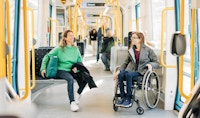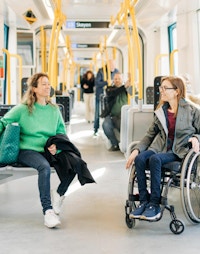How inclusive design brought Oslo’s ‘tram for all’ to life

Contact info for Stein-Fredrik Fossum
Strategic Design Lead,
Oslo
Contact info for Siri Yran
Industrial Design Lead,
Oslo
When Stein-Fredrik Fossum, Strategic Design Lead, and Siri Yran, Industrial Design Lead, set out to work on Oslo’s SL18 tram, they knew the seven-year project would be rooted in inclusive design. As the project came to life, so did insights about the importance of user testing, stakeholder collaboration, and what it really means to create a tram that is accommodating and welcoming to all.
We sat down with Siri and Stein-Fredrik to chat about their experience and learnings from this award-winning project.
This was a unique collaboration between Designit and several other suppliers. Tell us more about the Designit team’s role as a design-driven procurement partner.
We worked closely with designers from Ruter, the passenger-facing brand for Oslo’s public transport, as well as technical experts from Sporveien, Oslo’s tram and subway operator. We designed the user experience in collaboration with Ruter, while Sporveien oversaw the technical requirements.
Our involvement changed throughout the process to align with each of its phases. In the beginning, our role was to create the vision for the tram. On a user experience level, we considered what feelings and experiences we wanted to bring to life, and then we translated that into a visual guideline for the physical look and usability of the tram. Our early role was also to anchor the design decisions within a broad group of stakeholders.
As one of our stakeholders said, “A tram is rolling compromise on rails.” There are so many considerations to make. For example, we had to consider safety while balancing user testing and preferences, and then identify actionable opportunities and solutions from the findings. It required industrial design knowledge and a technical understanding of the development of physical products, with consideration for the product lifecycle and usability for many internal stakeholders such as drivers, passengers, maintenance personnel, and more.
Expanding on the idea that “a tram is rolling compromise on rails,” how did compromise help you ultimately create a solution rooted in inclusive design?
To achieve our end goal of a tram built for all, we knew we needed to start by getting alignment among all our experts and stakeholders and including them in every phase of the project. This started in phase one with the creation of our design guide. Representatives of various user groups voiced their opinions and experiences through co-creation workshops facilitated by Designit.
We engaged these large stakeholder groups in an iterative way, where we would first gather input in a workshop, then analyse and synthesise the material and present it back to the stakeholders in the next workshop. We would have everyone critique, discuss, and suggest changes and additions, then we would implement them for the next iteration. This happened several times until everyone agreed on the content and we could detail everything for the final version of the design guide.
Phase two was the evaluation of proposals. Designit was a part of various teams that oversaw evaluating the proposals received from vendors, and each team had a focus area: ‘passenger experience (interior and exterior)’, ‘driver cab’, and ‘cleaning and maintenance’. Designit’s role was to be the users’ advocate, negotiating with engineers and experts on how to score the various aspects of the tram that pertain to each focus area.
In the design phase of this seven-year project, we synthesised stakeholder needs to establish guidelines specific to the user experience, which are distinct from rigid technical specifications that are required by law. Due to the nature of inclusive design, our guidelines weren't obligatory in the same way as certain non-negotiable needs, like ensuring the breaks work properly – but they were still viewed as an extremely essential part of the project, and achieving alignment among our stakeholders was crucial to fostering that belief.
How did inclusive design help to drive positive outcomes for the end users (tram passengers)?
We brought together a mix of people from diverse departments, engaging owners, engineers, drivers, maintenance staff, and leaders. Partnerships with organisations for people with disabilities also enriched our approach. The end result was achieved through extensive interviews, observations conducted within the tram environment, and direct user input developed collaboratively with our varied group of stakeholders.
To address tram passengers' needs, we aimed to cater not only to permanent disabilities but also to temporary challenges like pregnancies, heavy bags, child-carrying, or rush hour travel. Our focus was on creating an open, flat floor space accommodating to wheelchairs, prams, and even bulky skiing equipment. Rather than tailoring solutions for a few, our goal was to make the tram welcoming, flexible, and suitable for many. We aimed to avoid stigmatising structures and instead to create an environment where the tram feels like an extension of an open sidewalk – inclusive of everyone.
Inclusive design wasn't just a goal; it was a necessity in this project, aligning with legal requirements for public transport to be universally accessible. It was a significant aspect of our design philosophy to ensure that the tram could serve everyone without discrimination.
How did your perspective on inclusive design evolve throughout the seven years of this project?
“User involvement requires a sensibility towards actually listening and acting on the insight identified. It is not a box to tick – it is a source of inspiration and validation,” says Siri. “Thanks to technical requirements, cost, and many other possibilities, there is always a risk of doing the research, involving real users, and then making a solution that doesn’t fit their needs. Through this project, we were able to take in the information from users and turn it into a solution that truly meets the needs of tram passengers.”
Says Stein-Fredrik, “By the end of the seven years, it was clear that if there are enough resources put in to do inclusive design properly, it really has a transformative effect. Inclusive design makes a real difference for passengers, and it was so rewarding to see it up close and confirm that truth in the final result.”
Do you have a project that could benefit from inclusive design? Want to explore other ways to bring user-centricity into your work? We’d love to chat.

